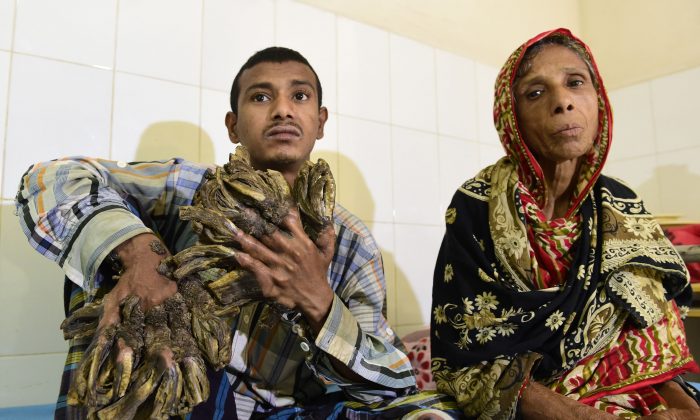The Bangladeshi national known worldwide as the “tree man” was forced to return to the hospital to undergo additional surgeries after going under the knife dozens of times in the last two years as he experienced a resurgence of the rare disease that affects him.
Abul Bajandar is believed to be one of the fewer than six people worldwide with the syndrome, known in the medical field as epidermodysplasia verruciformis. Doctors more than once have declard his condition cured but the growths, which look like tree bark and make him unable to use his hands, have kept appearing and spreading.
In May 2018 Bajandar was being treated at the Dhaka Medical College Hospital but he fled without notifying staff.
Now back at the hospital, he said he made an error.
“The growths have sprouted even in new parts of my feet and hands. I made a mistake leaving the hospital, but I hope doctors will be able to cure me fully this time,” Bajandar told AFP on Jan. 21.

Doctors are preparing to conduct a 26th surgery on Bajandar to try to treat the growths.
“His condition has deteriorated, and I think more surgeries will be required,” Samanta Lal Sen, the head plastic surgeon at the hospital, told AFP.
The syndrome had forced Bajandar, a former rickshaw driver, to stop working and his family has been struggling to survive. The hospital is treating him for free.
Doctors said that it might be too late, though.

“It’s a complicated case and we were making progress but he left to go home. I requested him many times to come back but he didn’t,” Dr. Samanta Lal Sen, co-ordinator at the Burn and Plastic Surgery Unit of Dhaka Medical College and Hospital, told CNN.
“He came back to the hospital on Sunday with his mother. He should have come here six months back. He came too late.”
In the intervening months, the symptoms had considerably worsened, with lesions on his hand now spanning around one-inch and warts spreading to his feet and other parts of his body.
Pictures show the growth and Bajandar at the hospital. One shows his feet partially covered by the growth, appearing as if he were walking in a muddy field and had only washed part of the mud off.

Because of the current condition of the man, doctors said he’ll likely need at least five more operations and have been working on a plan for his treatment.
Sen previously said that Bajandar first noticed the lesions when he was 10 but he didn’t get treatment until several years ago.
Bajandar, though distraught about the condition, said he still holds out hope that he’ll be able to live a normal life.
“I want to live like a normal person. I just want to be able to hold my daughter properly and hug her,” he said in 2016. This week, he added: “I strongly believe someday I will be able to live like a normal man.”

Epidermodysplasia Verruciformis
Little is known about the syndrome because it affects so few people.
But some is known. According to Orphanet, a European reference potral, the synrome “is a rare inherited genodermatosis characterized by chronic infection with human papillomavirus (HPV) leading to polymorphous cutaneous lesions and high risk of developing non melanoma skin cancer.”
The disease typically manifests during infancy, childhood, or puberty “with a progressive development of hyperpigmented or hypopigmented flat wart-like papules, irregular reddish brown plaques, seborrheic keratosis-like lesions and pityriasis versicolor-like macules on the trunk, neck, face, dorsal hands and feet (sun-exposed skin),” it added.
Experts said that three to six out of ten patients develop non-melanoma skin cancers in their 40s or 50s, mainly on sun-exposed areas. Black-skinned patients have a much lower incidence of skin cancer.
No permanent cures are currently known but a number of treatments have been developed. Surgical excision is thr treatment of choice.
According to the U.S. National Library of Medicine, the disease is heritable. A case presentation was made of a 14-year-old girl who underwent plastic surgery eight years after first developing lesions. The case was deemed a success, but was a much less severe case than Bajander’s, according to pictures of the female patient.


